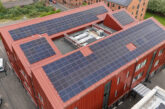
Luke Osborne, Energy & Emerging Technologies Solutions Advisor, identifies the reasons why prosumer installations will write a new chapter in the ‘Net Zero’ story.
The deployment of renewable energy sources such as on and offshore wind generation, solar photovoltaics (PV), and even biomass plants and anaerobic digestors has boomed in recent years.
Renewable energy accounted for nearly 40% of the energy provided to the UK electricity grid in 2022, just drawing ahead of fossil fuel energy. Electrotechnical contractors have a major role to play in continuing this transition, and a key driver will be Chapter 82 in Part 8 of the Wiring Regulations (BS 7671:2022).
Chapter 82, introduced as part of Amendment 2 to the Regulations in 2022, covers the key considerations for designers and installers working with prosumer technologies such as onsite generation and storage.
New challenges, new concepts
The concept of the prosumer (an energy producer and consumer) lies at the heart of Chapter 82, and ties together many different technologies that will become integral to our homes and offices. Buildings will increasingly be active components of the energy network, and the flow of energy will be bidirectional – moving to and from the grid, rather than unidirectional – only moving from the grid to our buildings.
It is important that our buildings, infrastructure and grid are equipped to handle new energy demands, low-carbon installations, and fluctuating loads, the likes of which our current network is not accustomed to. Lack of proper regulation around this would present obvious supply and other risks.
We all know that solar or wind can’t deliver when the sun doesn’t shine, or the wind doesn’t blow. However, it’s entirely possible to mitigate against these practical outcomes by pursuing various options:
- Install more renewables than we might need at any given time;
- build more battery and other storage solutions for any surplus energy;
- make the grid more flexible; and/or
- make our buildings more energy efficient.
In practice, the UK needs a combination of all four options, including giving more attention to boosting energy storage (batteries) and energy efficiency. Proper implementation of low to no-carbon technologies across the grid could represent savings of £30 – £70 billion for the UK economy, as pointed out in the recent BEIS publication, Transitioning to a Net Zero energy system: Smart Systems and Flexibility Plan 2021.
Why did we need a new Chapter?
To help deliver part of the required energy solution, Chapter 82 explains how smart grids and Prosumer Electrical Installations (PEIs) can interact. The smart grid will need to adapt to prosumers’ energy needs, and PEIs need to be able to reduce loads and provide a selection of power sources through Electrical Energy Management Systems (EEMS) which are set to become common in our industry.
The flexibility afforded by PEIs allows end-users to better control their energy usage and lets them take advantage of variable energy pricing, which is becoming a popular feature of supplier tariffs.
Smart, fully connected PEIs
The PEI plays a critical role in enabling the smart grid to accommodate the prosumer’s energy needs, while also reducing loads and providing a selection of power sources through electrical energy management systems. The PEI is a fully connected system that includes on-site generation, energy storage, heating systems, electric vehicle charge points, and home devices. To optimise the PEI’s components, an EEMS is needed to allow all the components to work collectively, managing energy demand from local consumption and any generated energy. Depending on the system employed, the EEMS can learn or be programmed by the user to time-shift devices to make use of any excess generation or store it in the battery for use at a later time.
In communicating with the grid, the EEMS can ‘load shift’ non-essential items during periods of high demand, reducing stress on the electricity network. This can include short-term switching-off of non-essential items, such as EV chargers or heating systems, with negligible impact on their overall operation.
When considering a PEI, it is useful to start by considering the building’s local distribution and how this connects to the public supply via the building’s origin of supply. Connected to the local distribution are the building’s appliances and any motorised devices, lighting and heating.
The implementation of circuit-level and appliance level metering is critical to PEI operation. Whilst common within the commercial sector, through Building Energy Management Systems (BEMS) and Building Automation Control Systems (BACS), these technologies are set to cascade through to domestic installations.
Detailed guidance for Members
Chapter 82 of the Wiring Regulations introduces contractors to a future of smart grids and a low carbon electricity network. With the inexorable rise of renewable energy and the increasing need for flexible and efficient energy systems, many more Members will be investigating how they can contribute to, and benefit from, the transition to a low carbon energy future.
ECA provides a range of more detailed technical guidance and resources for Members. Our Zero Carbon and ICCT groups, for example, meet regularly to discuss the changing landscape, new technologies and enable the creation of resources to help contractors stay up-to-date on the latest developments in this rapidly developing area.
In addition, our in-depth guide to Chapter 82 offers Members more detail about different PEI configurations, considerations for overloads and short-circuits, isolation, earthing arrangements, and much more.
Get more technical support and advice from ECA here












